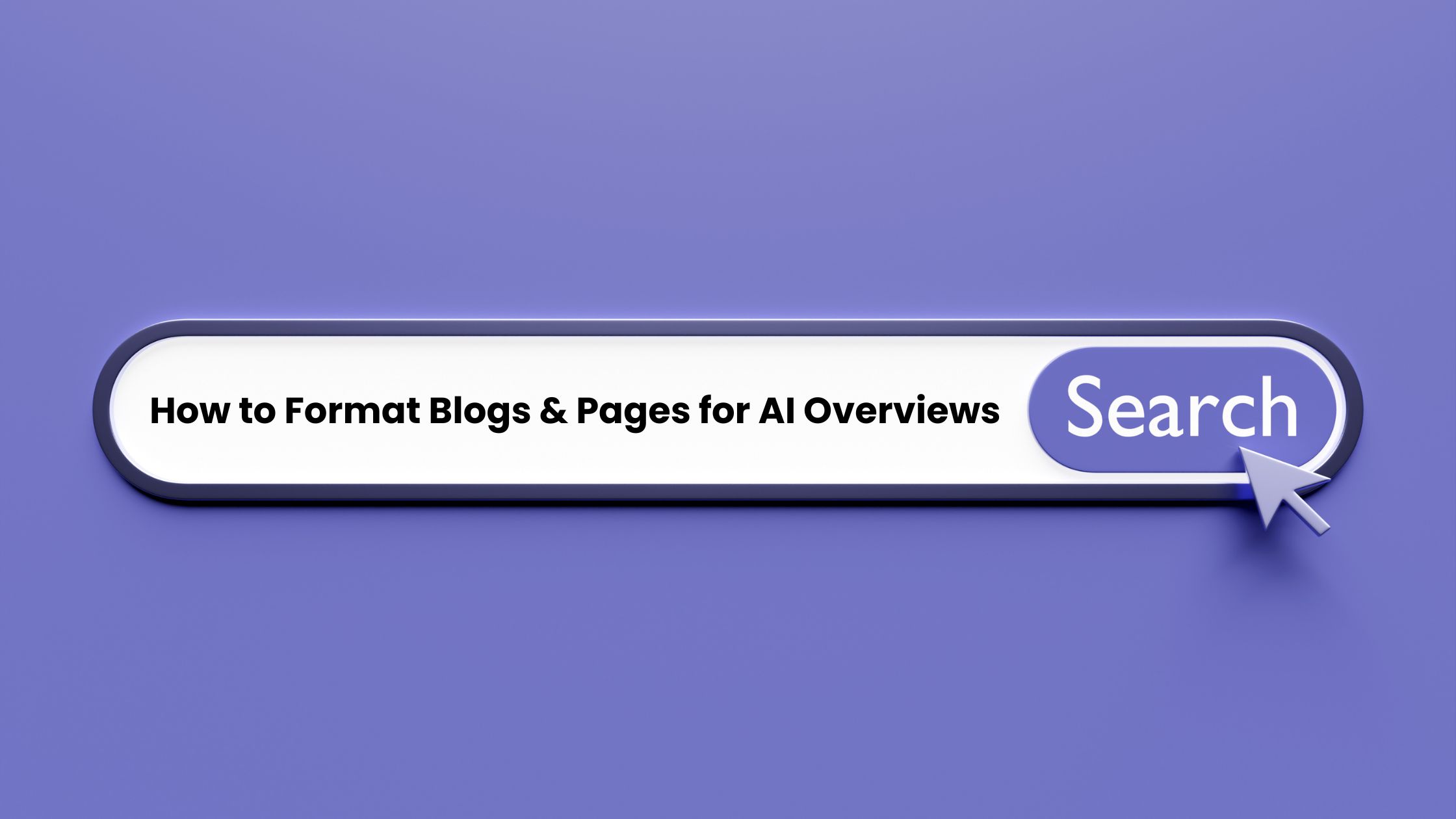In 2025, Google doesn’t just rank web pages — it rewrites the search experience.
With AI Overviews and zero-click results, your content either becomes the answer or disappears beneath it.
If you’re publishing blogs or landing pages for ecommerce, B2B, or local visibility, structure now matters as much as substance. AI systems like Google Gemini, ChatGPT, and Perplexity no longer crawl line by line — they scan, interpret, and cite information that’s formatted predictably.
This post breaks down exactly how to format your content so AI can understand, summarize, and cite it — helping your brand win visibility inside the answers, not just under them.
Why Content Format Matters More Than Ever
Google’s AI Overviews use generative summarization to provide direct answers to users. That means when someone searches “How to improve SEO for my NJ ecommerce site,” Google might show a concise answer — pulling lines, tables, or lists from multiple trusted pages.
If your page isn’t structured clearly, AI won’t extract it — no matter how accurate your content is.
AI-friendly content follows predictable formatting patterns:
- Short, scannable paragraphs
- Organized headings (H2s and H3s)
- Clear question-and-answer sections
- Schema markup for structured meaning
In short: structure = visibility.
Let’s unpack the framework that makes this possible.
The Science Behind AI-Readable Content
AI models interpret your content differently than humans.
They rely on semantic hierarchy (H1s, H2s, lists), structured data, and consistent context signals to detect what each section means.
Search engines like Google and chat systems like ChatGPT look for:
- Concise definitions (Answer Cards)
- Pattern recognition (headings, bullet lists, tables)
- Entity clarity (who, what, where, and why)
- FAQ or conversational formats (for voice and zero-click queries)
Example:
Two sites cover “AI SEO formatting.”
One uses headings, short paragraphs, and tables.
The other posts a 1,500-word block of text.
The structured version gets cited in AI Overviews.
The unstructured one vanishes.
The Core Elements of AI SEO Content Structure
Here’s the exact structure AI prefers when deciding which pages to feature or cite.
1. Clear, Descriptive Titles
Skip vague or clever titles. AI systems reward clarity.
Use direct titles like “How to Format Blogs for AI Search” instead of “Secrets to Smarter Content.”
Keep titles under 60 characters, include your target keyword once, and make the benefit obvious.
2. Strong Introductions with Mini Answer Cards
Your introduction sets the context — and your first two sentences may become your Answer Card (the snippet AI pulls).
Example:
AI SEO content performs best when it’s structured like an answer. Clear headings, concise paragraphs, and schema markup help AI systems understand and cite your content.
Start every post with clarity and value. Let readers (and AI) know what’s coming in the first 50 words.
3. H2 and H3 Hierarchy: Your Content’s Roadmap
Think of H2s as signposts for AI.
They define the main ideas.
Use H2s for core topics:
- “Why Content Format Matters”
- “Best Practices for AI Overviews”
- “Common Mistakes to Avoid”
Use H3s for supporting points or FAQs.
Phrase them naturally:
- “Do headings matter for AI SEO?”
- “How long should paragraphs be for AI readability?”
When your subheads match conversational queries, you improve voice search performance automatically.
4. Short Paragraphs and White Space
AI models break content into chunks to analyze meaning.
If your paragraphs are too long, they’re skipped.
Best practice:
- 2–4 lines per paragraph
- Use bullet points every 100–150 words
- Add visuals, tables, or block quotes to break monotony
Shorter paragraphs improve dwell time for readers and comprehension for machines.
5. Answer Cards Within Sections
Every major section should open with a two-sentence summary.
That’s your “mini Answer Card.”
Example:
AI SEO formatting depends on predictability. Consistent headings, lists, and schema make your pages readable and reference-ready for AI search.
These summaries teach AI exactly how to interpret the section — increasing your chances of inclusion in Overviews.
6. Tables and Comparisons
AI systems love structured data — and tables are the simplest way to present it.
Example:
| Element | Traditional SEO | AI SEO |
| Focus | Keywords & backlinks | Entities, schema, and context |
| Goal | Rank in SERPs | Get cited in AI answers |
| Format | Long text blocks | Structured answers & FAQs |
| Measurement | CTR & ranking | AI citations & voice visibility |
Tables like this serve two purposes:
- Readers grasp comparisons instantly.
- AI can parse and reuse that data as part of an Overview.
7. Visuals and Captions
AI doesn’t just process words — it decodes context.
Use descriptive image alt text and caption metadata that reinforce your main topic.
Example:
Alt text: “Example of AI SEO blog structure using Answer Cards and FAQ schema.”
These details strengthen entity recognition, especially for visual and voice-based search.
8. FAQs and Schema: Your Built-In AI Signals
Finish each post with 3–5 frequently asked questions.
Keep answers under 50 words and match conversational tone.
Example:
Q: Do headings really matter for AI SEO?
A: Yes. Headings create the structure that AI systems use to identify meaning and summarize sections.
Add the FAQPage schema to your code so AI systems know these are verified Q&As.
Tools: Schema Markup Validator, Google Rich Results Test.
Formatting for Voice Search and Conversational Queries
More than 70% of consumers now use voice search weekly.
When someone says, “Hey Google, what’s AI SEO?” — they’re triggering the same AI systems that generate Overviews.
To appear in these responses:
- Write in natural language (avoid jargon).
- Start headings with “how,” “what,” “why,” or “does.”
- Keep answers short and direct (under 25 words).
- Use lists for step-based topics.
Bonus tip:
Add a “Quick Answers” section halfway through your content.
It feeds both AI Overviews and smart speakers.
Schema and Structured Data — The Invisible Formatting Layer
Even perfect formatting can fail without a schema.
Schema markup translates your structure into machine-readable meaning — the language AI engines understand.
For blog content, use:
- Article / BlogPosting schema for metadata
- FAQPage schema for question-based content
- HowTo schema for guides
- LocalBusiness schema if you serve NJ locations
Test it using Google’s Rich Results Test or Schema Validator.
This invisible layer helps AI know what your content means — not just what it says.
Common Formatting Mistakes That Cost You AI Visibility
Even great writers make these AI SEO mistakes:
- Walls of text: AI models skip large blocks.
- Missing headings: No hierarchy means no understanding.
- Keyword stuffing: Hurts readability and semantic clarity.
- No schema: AI can’t parse meaning without markup.
- No FAQs or lists: Missed opportunities for snippets and voice answers.
Fix them by focusing on clarity, scannability, and question-based organization.
Remember: AI doesn’t need creativity — it needs consistency.
Example: AI-Optimized Blog Flow
Here’s what a winning page structure looks like in practice:
H1: How to Format Blogs for AI Search
Intro Paragraph: Includes a 2-sentence Answer Card summary
H2: Why Structure Matters
H3: How AI Reads Your Content
H2: Step-by-Step Formatting Framework
- Short paragraphs
- Bullet lists
- Tables for clarity
H2: FAQs About AI Content Formatting
H2: Get a Free AI Readiness Audit
This predictable hierarchy makes it easy for both humans and AI to consume.
How Premiere Creative Builds AI-Optimized Content
At Premiere Creative, we design every blog, service page, and ecommerce post using a simple rule:
Readable by humans. Reliable for machines.
Our process for NJ brands:
- Research PAA (People Also Ask) data and conversational voice queries.
- Structure every post with Answer Cards, tables, and internal links.
- Apply schema and validate using Google’s Rich Results Test.
- Monitor inclusion in Google AI Overviews and ChatGPT citations monthly.
This formatting framework has helped clients earn consistent visibility in AI-generated results — while maintaining traditional SEO growth.
Key Takeaways
- Structure determines visibility in AI search — not just keywords.
- Use concise headings, short paragraphs, and answer-based sections.
- Add schema markup to make meaning machine-readable.
- Format content for both AI and voice — clear, conversational, and scannable.
- Every page should include an Answer Card, a table, and a mini FAQ cluster.
If you want AI to cite your brand, write like you’re already the source.
Ready to See If Your Content Is AI-Ready?
Formatting for AI SEO isn’t complicated, but it is intentional. Small changes in structure can unlock massive visibility gains. Discover how your pages perform in AI search, and see what to fix to appear in Overviews, voice results, and zero-click answers.

